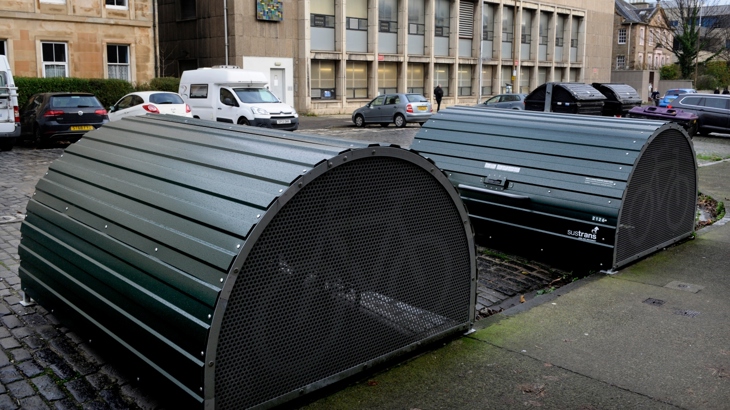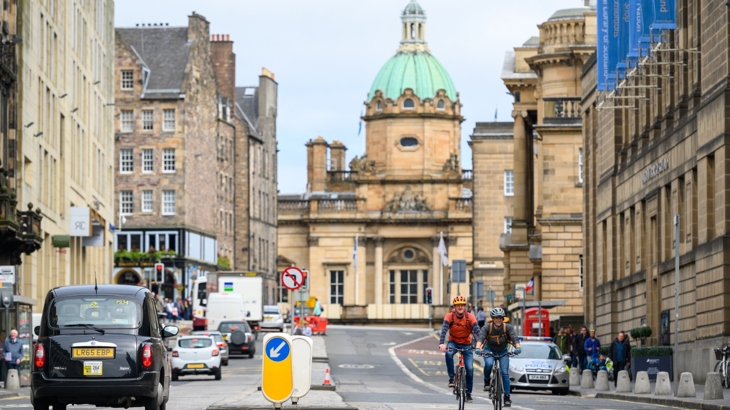In this blog, we hear from Kirsty who started using her bike as a mobility aid after a collision with a lorry driver left her with walking problems. As an Edinburgh-based campaigner for safe infrastructure, she explains the challenges she faces as a disabled cyclist in the city and the changes she would like to see to improve the experience.

Kirsty on her bike at Portobello. Credit: Kirsty Lewin
Kirsty Lewin has been keen on cycling since she was a little girl.
As a student in Edinburgh she cycled everywhere – no one had cars and it was the only way to travel around the city.
In 1989, Kirsty did her first major cycle tour, pedalling across Australia where she had spent her childhood.
This was the first of many long-distance trips which included time in Ecuador, New Zealand and Morocco.
But after a collision with a lorry driver in 2008, her relationship with cycling changed.
Kirsty shares her story with us below.
Picking the bike back up
After the collision, I had to get back on the bike as I couldn’t walk far and it was the only mode of transport I could use.
I was cycling for rehab purposes, but I was really anxious on the road.
In fact, I still am.
The rehab was slow but effective – while I couldn’t run, I was progressing at cycling further and further.
However, due to my injuries I later developed severe arthritis in one knee which is disabling when it flares.
Cycling on my road bike became difficult and painful, but I discovered I could cycle pain-free on an e-bike.
I got my first e-bike three years ago and it was a game-changer.

Secure, covered cycle storage, that's close to the entrances of public buildings and transport hubs would make cycling more accessible for disabled people. Credit: Colin Hattersley
A changing relationship with cycling
I have become much more reliant on my bike.
If my knee is flaring, I can cycle to the local shop, into town and to medical appointments.
I can’t use the bus, and I don't have a car so without the bicycle I would be stranded and dependent on others.
That's why good infrastructure is so important for people like me.
I find it frustrating that a minority of people campaign against cycle infrastructure on behalf of disabled people when so many disabled people are using cycles as mobility aids.
Raising awareness of people who cycle and are disabled
There's a growing awareness that many disabled people cycle.
People in the policy world are starting to recognise it, and organisations such as Sustrans are working with disabled people on improving access and comfort on new and existing infrastructure.
However, there’s a lot more to be done and I don't think there's enough recognition about the benefits of cycling for people with conditions such as arthritis.
So many people could benefit from cycling, but it might not occur to them to try.
People need to find a cycle that works for them – an e-bike might be the best thing - but they’re expensive and not accessible for everyone.
Storage can also be a real challenge.
I live in a top floor flat and about the time I bought the e-bike, after 10 years of campaigning, we finally got a cycle hangar at the end of the street.
There’s no way I could carry my bike up to the flat and storing bikes on the ground floor is impractical.
Many people who would benefit from cycle hangars have no access to them, and in Edinburgh there’s a long waiting list for spaces.

Edinburgh is a compact city - cycling safely and comfortably should be possible for everyone that wants to. Credit: John Linton
Cycling in Edinburgh with a disability
Where I live in Portobello there is no safe, comfortable route to the city centre.
There are segments that are good, but there are no complete routes.
I have to choose between the Innocent Tunnel, which is isolated and intimidating, or roads with aggressive and abusive drivers.
If you're an anxious cyclist like me, choosing a safe route is a constant dilemma.
There are plans for improving infrastructure in Edinburgh.
This is great, but it needs to be done without compromising design and faster delivery is required.
Improving the experience
Edinburgh is a compact city.
So many more disabled people could and would cycle if there was better infrastructure in place.
We also need a lot more secure, covered cycle storage, particularly close to the entrances of public buildings and transport hubs.
I’d like to see on-road routes that are physically protected from traffic and quiet routes which are genuinely quiet.
There are still chicanes, metal barriers, streets without dropped kerbs, and shared use paths with cars parked on them.
While these may seem like small things, they can pose major difficulties for disabled people cycling.
We also need traffic reduction and speed reduction.
20mph zones need to be enforced and more strategic cycling routes need speed limit reductions.
People like me who are anxious on the road need to be able to trust drivers, but I don't and can’t.
There are simply too many drivers driving aggressively and irresponsibly.
Cycling safely and comfortably around the city should be possible for everyone who wants to.
This is something I am and will continue to campaign for.
Kirsty is a writer and campaigner who founded the InfraSisters – a group of women that campaigns for night-time cycle infrastructure that is safe and comfortable for women and girls.
Read more about how our neighbourhoods exclude disabled people and what needs to change.





